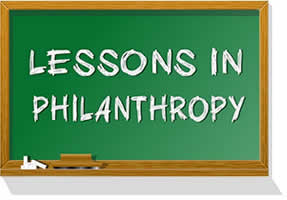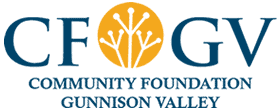Lessons in Philanthropy
 Philanthropy – the basic concept of benevolence – has a very long history. It can be traced back to ancient Chinese and Hindu cultures when it was deliberately built into societal structures. The Greeks gave us the word “philanthropy” and philosophers identified its crucial role in the development of democracy. The concept of philanthropy is found in cultures in ancient Africa, Indigenous American traditions, and the teachings of all major religions. Clearly philanthropy has been an important part of human societies for thousands of years. But how do we define and utilize philanthropy in modern times?
Philanthropy – the basic concept of benevolence – has a very long history. It can be traced back to ancient Chinese and Hindu cultures when it was deliberately built into societal structures. The Greeks gave us the word “philanthropy” and philosophers identified its crucial role in the development of democracy. The concept of philanthropy is found in cultures in ancient Africa, Indigenous American traditions, and the teachings of all major religions. Clearly philanthropy has been an important part of human societies for thousands of years. But how do we define and utilize philanthropy in modern times?
Modern philanthropy builds on the ancient concept of the word. Yes, fundamentally it’s the “giving” of what the nonprofit industry refers to as The Three Ts (Time, Talent, and Treasure), but modern philanthropy is more. It’s kindness and generosity, but it’s also altruism and humanitarianism. And nowadays it’s becoming more synonymous with change. According to the National Philanthropic Trust, “today we define philanthropy as the practice of organized and systematic giving to improve the quality of human life through the promotion of welfare and social change.”
This enhanced concept of philanthropy has been the driving force behind some of the most fundamental societal changes of the last century. It fills the rather large gaps between what business and government provides. It reminds us what is worth preserving and protecting, and reveals what is in need of improvement. It motivates us to be better and encourages us to equitably share societal prosperity with all.
I don’t need to tell you how the past year has been unprecedented. But what has become unavoidably clear is the fact that we still have some serious societal issues that need to be addressed. And the philanthropic sector is facing them head-on, learning important lessons along the way.
Modern philanthropy is constantly improving, becoming more professional and sophisticated. Nonprofit organizations are focusing more resources on their role as advocates. Funders are shifting their grantmaking to “trust-based philanthropy,” which empowers the organizations that are serving on the frontlines of our most difficult challenges. The nonprofit industry as a whole is retooling and collaborating in new and inventive ways to develop solutions rather than just treating the symptoms of systemic issues. And this is all happening here in our Valley, too.
The larger lessons of modern philanthropy are being learned here in microcosm. Local nonprofits have become creative in how they raise revenue and innovative in their program delivery. Organizations are collaborating to tackle big issues with long-term strategies. Nonprofit leaders are proactively learning from their for-profit counterparts and each other to make their organizations more efficient and effective. And, here at the Community Foundation, we’re shifting how we think about grantmaking, focusing more on funding operations rather than specific projects and nurturing creative partnerships that address community-wide issues.
If you’re anything like me, the past year has added fuel to your desire to affect real, lasting change in our community. But how, you ask? The answer is simple: apply the lessons of modern philanthropy to your life. Embody the ancient concepts that define philanthropy – give your time, talent, and treasure – but expand on them. Embrace altruism. Advocate for those who have no power. Speak out when you see injustice. Work with your neighbors to make our community more diverse and resilient. Encourage and enable local nonprofits to do and be more. Flood the world with kindness and generosity. Learn and grow each and every day.
Whether ancient or modern, the lesson that philanthropy teaches us above all else is how to be human.
Written by Alicia Corliss



